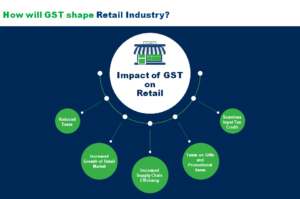Unclear – about retail trade in new tax regime – GST Law:
- unclear and confusing concept of retailing
- companies say retailers refusing to buy fresh stocks
- retailers want consumer firms to protect margins
 A tussle has erupted between large consumer companies and organised trade just ahead of the introduction of the goods and services tax (GST) on July 1. Companies say that large retailers are refusing to buy fresh stocks starting June 26 till the month ends, while retailers want consumer companies to protect margins.
A tussle has erupted between large consumer companies and organised trade just ahead of the introduction of the goods and services tax (GST) on July 1. Companies say that large retailers are refusing to buy fresh stocks starting June 26 till the month ends, while retailers want consumer companies to protect margins.
- retailers face the unclear details for retailing trade
- there is confusion among the trade about buying fresh stocks now
- there will be some wholesalers and retailers who will be out of stock for a while
- leading to a shortage of products on shelves
- while in the long term, GST is positive
- it will take about a quarter for things to settle down
- the transitory disruption is expected to stabilise by next quarter
- there is a significant thinning of the inventory pipeline
- since a lot of the trade is not buying new stocks just ahead of GST
A fortnight ago, the biggest names in the country’s organised retail sector — Future Group, Reliance Retail, Tata Group, D’Mart and Aditya Birla Retail — said they wanted consumer companies to protect their post-tax absolute margins instead of only the percentage after introduction of GST on July 1. GST will subsume the factory-gate levy, excise, thus reducing the absolute margins available to a retailer.
Most processed foods, home and personal care products, such as cookies, toothpastes, soaps and hair oils, will be taxed at 18% under GST compared with about 22% in the current indirect tax structure of excise duty and value-added tax (VAT). However, detergents, shampoos, and skin-care products will attract 28% GST.
Retailers, especially small retailers are still grappling with the unclear goods and services tax regime for retailing, which will come into effect from 1 July. With a few days left for GST to come into effect, retailers are still in the dark about the details and are refraining from restocking. However, it is unlikely to hit consumers yet.
GST, the most-talked-about tax reform of the NDA government that seeks to make India one market, subsumes a host of central and state taxes like excise duty, service tax and VAT, in the first year. However, media reports have said that many of the businesses are yet not ready for the rollout as the systems are not in place yet and has unclear details.
Retailers worry about not getting credit for their existing inventories once GST comes into force on 1 July.
- there is unclear impact of GST on retailers
- this has forced many to not stock up
- the reason is that most brands tend to corner the investment the retailers put into their inventory
- a tech-enabled demand sensing and aggregation platform that connects brands with retailers, especially small retail outlets and mom-and-pop stores
- the small retailer is worried about his margins and is now not refreshing his stocks.
- the GST has a four-slab rate structure at 5, 12, 18 and 28 percent
- the multiple rates bring complexity in interpretation and classification leading to tax disputes
- most retailers are still confused about the bracket that a commodity will be taxed under
- thus, under GST, the retailer is not clear about the slab the product will come under
Many retailers buy goods directly from the wholesalers while some do it indirectly. What they would like to know is whether they can take CENVAT. This is in respect of central excise on inputs purchased for the manufacture or duty paid in relation to the manufacture of the final product.
 Small retailers especially are worried about the international HS Code, developed by the World Customs Organisation. It refers to Harmonised Commodity Description and Coding System. HS Code has around 5,000 commodity groups with every single of them identified by a six digit code. Over 200 countries and economies use it as a basis for their Customs tariffs and for the collection of international trade statistics.
Small retailers especially are worried about the international HS Code, developed by the World Customs Organisation. It refers to Harmonised Commodity Description and Coding System. HS Code has around 5,000 commodity groups with every single of them identified by a six digit code. Over 200 countries and economies use it as a basis for their Customs tariffs and for the collection of international trade statistics.
Under GST, HS code has several chapters and most small retailers do not yet know under which category they will be taxed and hence are very uncomfortable about it.
The Confederation of All India Traders (CAIT) has also requested the government to suspend implementation of e-way Bill and HSN Code for six months. The traders body wants the government to sit with traders to iron out initial difficulties in compliance.
CAIT has asked the government to clarify which products will come under the ambit of unbranded goods, saying that a lot of confusion has erupted over it among traders.
According to CAIT, stocks pertaining to the period up to the previous one year from date of GST implementation only considering for availing input credit. Allowance of full input credit of Value Added Tax on such stock.
Earlier VAT was not applicable to sellers with a turnover below Rs 10 lakh per annum and now GST law expand it to include below Rs 20 lakh per annum. Under VAT, the Rs 10 lakh limit only applied for transactions which were within the same state of VAT registration. There was hoping that under the new GST law the sellers below Rs 20 lakh limit will also be able to now sell to any state as GST claims to be “One nation one tax” tax law. But this is not clear in the GST documentation provided so far.
The announcement of GST has increased the administrative cost for the textile industry. Although, GST has increased the tax rate, on the other side it has now allowed claiming input credit which may be between 6–9 percent. The textile industry is the second largest industry in India which provides skilled and unskilled employment. Though there is no excise tax on ready-made garments, the industry was still paying VAT of 5.5-6 percent and 7-7.5 percent for garments above Rs 1,000. The difference in the tax rate offset by embedded tax credit. Presuming the prescribed tax rate is higher than the current rate, it would be best to keep the existing stocks at a minimum since input tax credit on the current stock would be available at old rates but future supplies tax at higher rates.
As the government unrolls its much-awaited and also contentious programme, it is not just the small retailers who are on tenterhooks. The government’s one-tax-one-regime has also some of the big names in retail in a flux. All we want is that our margins should be protected under GST. “Wholesalers have agreed to pass on the benefits that they get from GST to the consumers, but we would reiterate that consumer companies should protect our post-tax absolute margins instead of only a percentage after introduction of GST on July 1.
- Upto 60 per cent off on clothing, apparel and footwear from top brands
- Sellers at Kraftly, Kartrocket’s C2C marketplace, is offering discounts to liquidate their inventory.
- It has seen tardiness in sellers to add new collection in their inventories.
- Given the confusion, retailers’ worry about incurring losses is understandable.
- They are selling items at deep discounts in a bid to clear inventories before the new regime kicks in.
- Online as well as offline retailers are running major sales, while apparel is one of the biggest categories here.
- Brands like Puma, Reebok, Vero Moda, Only, Jack & Jones among others are offering steep discounts on clothes and footwear.
With the Goods and Services Tax (GST) roll out just few days away —-
- several fashion and sports brands are holding clearance
- and end-of-season sales to sell out current stocks
- before the new tax regime kicks in.
- Some of the biggest clothes and footwear brands
- are offering steep discounts on various products
- and if you’re an avid shopper,
- you will want to take advantage of this particular opportunity
- to save money on premium buys that you won’t regret.
GST is the reason that retailers are hustling to clear stocks before July 1, and shoppers are sure to benefit from this sudden sale season. Some of the major retail chains, online and retail stores, as well as online shopping websites are offering as much as 40 to 50 per cent discount on some of the top clothing, apparel and footwear brands like Puma, Bata, Only, Jack & Jones, Vero Moda, etc.
Top online shopping websites like
- Flipkart,
- Amazon and
- others are also holding end of season sales on fashion products, clothes and footwear.
There are heavy discounts on fashion accessories like
- watches and jewelry,
- as well as hand bags, and
- electronics like smartphones, etc.

